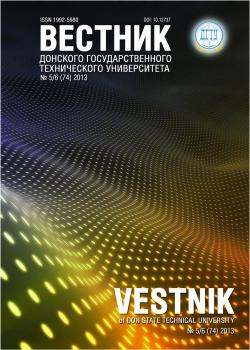The problem of elastic sliding in the ‘wheel — road surface’ contact is considered. A mathematical surface interaction model is developed. The model presented here suggests that the road surface deformation processes can be neglected. The wheel is modeled as a set of elastic rim sectors mounted on an elastic disc. The model dynamics is mainly influenced by the interaction force of the rim sectors with the wheel center, the intersectional interaction force, and the contact surface interaction force. The experimental studies using numerical simulation methods are conducted. It is discovered that there is a dependence of the stalling load value on the other wheel properties. The obtained results are of interest for solving problems on the wheel motion control to prevent the contact disruption. The used holistic approach allows identifying the emergence that influences the overall system trajectory.
“wheel — road surface” system, deformation, friction force, elastic slip.
Введение. Проблеме динамики взаимодействия колеса с полотном посвящены многочисленные исследования. При этом анализ динамической системы машины основывается на изучении взаимодействия этой системы с динамической связью, формируемой трибосопряжением в области контакта. В известных исследованиях динамическая характеристика фрикционного узла рассматривается как заданная: её параметры не зависят от упругих свойств колеса [1–4]. В отличие от этих работ в предлагаемом исследовании доказывается, что свойства формируемой фрикционной связи не являются инвариантными к упругим характеристикам колеса. Тем самым уточняются и дополняются многие известные свойства системы.
Данная работа посвящена уточнению закономерностей формирования упругих характеристик обода колеса и их влияния на трибологические свойства пятна контакта, обусловливающие режим его функционирования (сцепление/скольжение).
1. Zakovorotny, V. L. Dinamika tribosistem. Samoorganizatciia, evoliutciia. [Dynamics of tri-bosystems. Self-organization, evolution.] Rostov-on-Don: DSTU Publ. Centre, 2003, 502 p. (in Russian).
2. Zakovorotny, V. L., Shapovalov, V. V. Problemy dinamiki transportnykh tribosistem. [Problems of dynamics of transport tribosystems.] Sborka v mashinostroenii, priborostroenii, 2005, no. 12, 502 p. (in Russian).
3. Zakovorotny, V. L., Shapovalov, V. V. Issledovanie kompleksnogo koeffitcienta treniia. [Study of the complex friction coefficient.] Trenie i iznos, 1987, no. 12, pp. 22-24 (in Russian).
4. Johnson, K. Mekhanika kontaktnogo vzaimodeistviia. [Mechanics of contact interaction.] Mos-cow: Mir, 1989, 509 p. (in Russian).
5. Lyapushkin, N. N. Model stcepleniia i dinamika dislokatcii. [Model of coupling and dynamics of dislocations.] Mir transporta, 2004, no. 11, pp. 10-15 (in Russian).
6. Markov, D. P. Koeffitcienty treniia i stcepleniia pri vzaimodeistvii koles s relsami. [Friction and adhesion coefficients under the interaction of wheels and rails.] Vestnik VNIIZhT, 2005, no. 4, p. 3 (in Russian).
7. Lapshin, V. P., Turkin, I. A., Nosachev, S. V. Model sviazi uprugo-viazkogo smeshcheniia poverkhnosti kolesa otnositelno relsa s tiagovymi kharakteristikami. [Bond model of viscoelastic wheel surface shift relative to rail with pull characteristics.] Vestnik of DSTU, 2012, no. 5, pp. 40-49 (in Russian).
8. Nosachev, S. V., Chuveyko, M. V. Model uprugogo skolzheniia v sisteme «koleso - poverkh-nost dorogi». [Elastic slip model in ‘wheel - road surface’ system.] Vestnik of DSTU, 2013, no. 3-4 (72-73), pp. 111-116 (in Russian).





